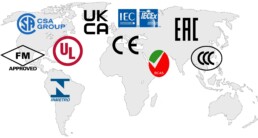ATEX, IECEx, NEC Explosion Protection Product Design
Explosionproof | Intrinsic Safety | Encapsulation | Increased Safety
Our team at Ex Dynamics have vast experience of hazardous area certification and how to design products for explosive atmospheres. We can assist in all aspects of your project, from initial feasibility study, through to full hazardous area product design. We also work as consultants, to help clients enter the complex Explosion Protection market and advise on what is required for ATEX or IECEx Certification.
We have extensive knowledge of ATEX, IECEx and North American (NEC) explosion protected equipment and protective systems. Utilising established relationships with certification bodies, we can quickly develop world beating products, using the most efficient path. Our experience means, for example, we know how to design flameproof enclosures or the best way to design Intrinsically Safe circuits. These, along with knowing how to use other ATEX, IECEx and NEC protection concepts, allows us to design products on time and on budget.

Hazardous Area Classifications
Hazardous areas are classified depending on the risk of an explosive substance being present. The classification is defined differently depending on the region and standards used. North America and Canada use both Class, Division and Class, Zone based systems whereas regions working with IECEx or ATEX use a Zone classification.
| Class, Division | AEx Zone | ATEX/IECEx | Definition |
|---|---|---|---|
| Class I, Div 1 | Class I, Zone 0 | Zone 0 | Presence of an explosive gas atmosphere continuously, frequently or for extended periods |
| Class I, Zone 1 | Zone 1 | Occasional presence of an explosive gas atmosphere under normal operation | |
| Class I, Div 2 | Class I, Zone 2 | Zone 2 | An explosive gas atmosphere is unlikely to occur in normal operation and if it does, disperses quickly |
| Class II, Div 1 | Zone 20 | Zone 20 | Presence of an explosive cloud of dust in air continuously, frequently or for extended periods |
| Zone 21 | Zone 21 | Occasional presence of an explosive cloud of dust in air under normal operation | |
| Class II, Div 2 | Zone 22 | Zone 22 | An explosive cloud of dust in air is unlikely to occur in normal operation and if it does, disperses quickly |
| Class III, Div 1 | - | - | Ignitable fibres and flyings present continuously or under normal operation |
| Class III, Div 2 | - | - | Presence of ignitable fibres and flyings is not likely under normal operation |
Hazardous Area Protection Concepts
Protection concepts are chosen at the outset when designing a hazardous area product since it must be independently tested and certified prior to product sale to ensure safety. Each protection concept has its own advantages and drawbacks depending on the product type, area classification and region. To complicate matters further, even though some of the protection concepts behind hazardous area design are common between regions, the requirements can vary. Ex Dynamics have experience of working through these differences to deliver our customers products with universal global certification.
| Ex Standard | Protection Concept |
|---|---|
| EN/IEC/UL 60079-0 | General requirements for apparatus used in explosive atmospheres |
| EN/IEC/UL 60079-1 | Equipment protection by flameproof enclosures ‘d’ |
| EN/IEC/UL 60079-2 | Equipment protection by pressurised enclosure ‘p’ |
| EN/IEC/UL 60079-5 | Equipment protection by powder filling ‘q’ |
| EN/IEC/UL 60079-6 | Equipment protection by liquid immersion ‘o’ |
| EN/IEC/UL 60079-7 | Equipment protection by increased safety ‘e’ |
| EN/IEC/UL 60079-11 | Equipment protection by intrinsic safety ‘i’ |
| EN/IEC/UL 60079-15 | Equipment protection by restricted breathing ‘nR’ and sealed devices ‘nC’ |
| EN/IEC/UL 60079-18 | Equipment protection by encapsulation ‘m’ |
| EN/IEC/UL 60079-28 | Protection of equipment and transmission systems using optical radiation |
| EN/IEC/UL 60079-31 | Equipment dust ignition protection by enclosure ‘t’ |
| EN/IEC/UL 60079-33 | Equipment protection by special protection 's' |
| ISO/UL 80079-37 | Non-electrical equipment – protection by constructional safety ‘c’, control of ignition sources ‘b’ and liquid immersion ‘k’ |
Working to the 60079 series of standards gives access to European and other markets working to the IECEx scheme, but to access North American Class, Div markets, other standards and approvals must be included in the scope.
| USA Standard | Canadian Standard | Protection Concept |
|---|---|---|
| FM 3600 | CSA C22.2 No. 0 | General requirements for equipment for use in hazardous locations |
| ANSI/UL 913 FM 3610 | CSA C22.2 No. 60079-11 | Intrinsic safety equipment |
| ANSI/UL 1203 FM 3615 | CSA C22.2 No. 30 | Explosion-proof electrical equipment |
| ANSI/UL 1203 FM 3616 | CSA C22.2 No. 25 | Dust-ignition-proof electrical equipment |
| ANSI/UL 121201 FM 3611 | CSA C22.2 No. 213 | Nonincendive electrical equipment |
| ANSI/NFPA 496 FM 3620 | ANSI/NFPA 496 | Purged and pressurized enclosures |

Related Articles
Differences Between ATEX and IECEx Certification
ATEX Battery Design
Ex Dynamics employ Ex design engineers experienced in IECEx and ATEX battery design using intrinsic safety 'i', increased safety 'e', flameproof enclosures 'd', and encapsulation 'm'. Our hazardous areas experience allows us complete projects quickly and compliant to the appropriate standards. If you have a custom ATEX battery requirement, get in touch to discuss how Ex Dynamics can help.Read more
Time To Subcontract ATEX Product Development?
Subcontracting ATEX product development for hazardous area equipment and devices saves time and cost. Experience counts, especially if certifying products to global standards. Ex Dynamics offers consultation, development of product derivatives or entire product ranges.

